Datalog
Introduction
Datalog is a declarative logic programming language that serves as a query language for deductive databases. It is a subset of Prolog, with the notable difference that Datalog is a purely declarative language, while Prolog allows for procedural programming. Datalog is often used in data analysis, program analysis, and database integration.
History
Datalog was first introduced in the 1970s as a theoretical model for relational databases. The language was designed to be a simpler, more efficient alternative to the complex SQL language used in most databases. The goal was to create a language that was easy to use and understand, while still being powerful enough to handle complex queries.
Language Structure
Datalog programs consist of a finite set of rules. Each rule is a clause of the form:
A :- B1, ..., Bn.
where A and Bi are atomic formulas. The symbol ":-" is read as "if" or "is implied by". The atomic formula A is the head of the rule, and B1, ..., Bn is the body. The meaning of the rule is: if all atoms in the body are true, then the atom in the head is also true.
Syntax
Datalog's syntax is similar to that of Prolog. However, Datalog eliminates many of the more complex features of Prolog, such as the cut operator, making it a simpler and more predictable language. The basic elements of Datalog syntax are:
- Atoms: An atom is a predicate symbol followed by a parenthesized list of terms. For example, in the atom p(a, b), p is the predicate symbol and a and b are terms.
- Terms: A term is either a constant, a variable, or a function symbol applied to a list of terms.
- Rules: A rule is a single atom (the head of the rule) followed by ":-" and a comma-separated list of atoms (the body of the rule). For example, the rule p(a) :- q(a, b), r(b) states that if q(a, b) and r(b) are true, then p(a) is also true.
Semantics
The semantics of Datalog are based on the concept of a Herbrand interpretation. An interpretation assigns a truth value to each ground atom of the program. A ground atom is an atom in which all terms are constants. The semantics of a Datalog program is the least Herbrand interpretation that satisfies all its rules.
Applications
Datalog is used in a variety of applications, including:
- Data analysis: Datalog's declarative nature makes it well-suited for data analysis tasks. The user specifies what information they want, and the Datalog engine determines how to retrieve it.
- Program analysis: Datalog can be used to analyze and reason about programs. For example, it can be used to detect bugs, verify properties, or optimize code.
- Database integration: Datalog can be used to integrate data from multiple databases. The user specifies the desired integration using Datalog rules, and the Datalog engine performs the integration.
Limitations
While Datalog is a powerful language, it has some limitations. For example, it does not support arithmetic operations or complex data structures. Additionally, while Datalog is efficient for certain types of queries, it can be less efficient than procedural languages for other types of queries.
See Also
- Prolog - Relational database - Declarative programming - Logic programming - Deductive database


